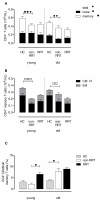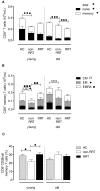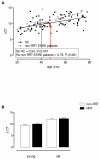Uremia causes premature ageing of the T cell compartment in end-stage renal disease patients
- PMID: 22971545
- PMCID: PMC3482595
- DOI: 10.1186/1742-4933-9-19
Uremia causes premature ageing of the T cell compartment in end-stage renal disease patients
Abstract
Background: End-stage renal disease (ESRD) patients treated with renal replacement therapy (RRT) have premature immunologically aged T cells which may underlie uremia-associated immune dysfunction. The aim of this study was to investigate whether uremia was able to induce premature ageing of the T cell compartment. For this purpose, we examined the degree of premature immunological T cell ageing by examining the T cell differentiation status, thymic output via T cell receptor excision circle (TREC) content and proliferative history via relative telomere length in ESRD patients not on RRT.
Results: Compared to healthy controls, these patients already had a lower TREC content and an increased T cell differentiation accompanied by shorter telomeres. RRT was able to enhance CD8+ T cell differentiation and to reduce CD8+ T cell telomere length in young dialysis patients. An increased differentiation status of memory CD4+ T cells was also noted in young dialysis patients.
Conclusion: Based on these results we can conclude that uremia already causes premature immunological ageing of the T cell system and RRT further increases immunological ageing of the CD8+ T cell compartment in particular in young ESRD patients.
Figures




Similar articles
-
Cytomegalovirus contributes partly to uraemia-associated premature immunological ageing of the T cell compartment.Clin Exp Immunol. 2013 Dec;174(3):424-32. doi: 10.1111/cei.12188. Clin Exp Immunol. 2013. PMID: 23962178 Free PMC article.
-
Uremia-associated immunological aging is stably imprinted in the T-cell system and not reversed by kidney transplantation.Transpl Int. 2014 Dec;27(12):1272-84. doi: 10.1111/tri.12416. Epub 2014 Sep 30. Transpl Int. 2014. PMID: 25082296
-
T-cell ageing in end-stage renal disease patients: Assessment and clinical relevance.World J Nephrol. 2014 Nov 6;3(4):268-76. doi: 10.5527/wjn.v3.i4.268. World J Nephrol. 2014. PMID: 25374821 Free PMC article. Review.
-
Latency for cytomegalovirus impacts T cell ageing significantly in elderly end-stage renal disease patients.Clin Exp Immunol. 2016 Nov;186(2):239-248. doi: 10.1111/cei.12846. Epub 2016 Aug 19. Clin Exp Immunol. 2016. PMID: 27460884 Free PMC article.
-
Chronic kidney disease and premature ageing of the adaptive immune response.Curr Urol Rep. 2015 Jan;16(1):471. doi: 10.1007/s11934-014-0471-9. Curr Urol Rep. 2015. PMID: 25404185 Review.
Cited by
-
Decreased Peripheral Naïve T Cell Number and Its Role in Predicting Cardiovascular and Infection Events in Hemodialysis Patients.Front Immunol. 2021 Mar 17;12:644627. doi: 10.3389/fimmu.2021.644627. eCollection 2021. Front Immunol. 2021. PMID: 33815398 Free PMC article. Clinical Trial.
-
Immune System Dysfunction and Inflammation in Hemodialysis Patients: Two Sides of the Same Coin.J Clin Med. 2022 Jun 28;11(13):3759. doi: 10.3390/jcm11133759. J Clin Med. 2022. PMID: 35807042 Free PMC article. Review.
-
End-stage renal disease, dialysis, kidney transplantation and their impact on CD4+ T-cell differentiation.Immunology. 2018 Oct;155(2):211-224. doi: 10.1111/imm.12947. Epub 2018 May 25. Immunology. 2018. PMID: 29722011 Free PMC article.
-
Uremia-Associated Ageing of the Thymus and Adaptive Immune Responses.Toxins (Basel). 2020 Apr 3;12(4):224. doi: 10.3390/toxins12040224. Toxins (Basel). 2020. PMID: 32260178 Free PMC article. Review.
-
Factors associated with the elevated percentage of CD4CD69 T cells in maintained hemodialysis patients.Ren Fail. 2017 Nov;39(1):547-554. doi: 10.1080/0886022X.2017.1349672. Ren Fail. 2017. PMID: 28726529 Free PMC article.
References
-
- Litjens NH, van Druningen CJ, Betjes MG. Progressive loss of renal function is associated with activation and depletion of naive T lymphocytes. ClinImmunol. 2006;118:83–91. - PubMed
-
- Vanholder R, Ringoir S. Infectious morbidity and defects of phagocytic function in end-stage renal disease: a review. J Am Soc Nephrol. 1993;3:1541–1554. - PubMed
LinkOut - more resources
Full Text Sources
Medical
Research Materials

